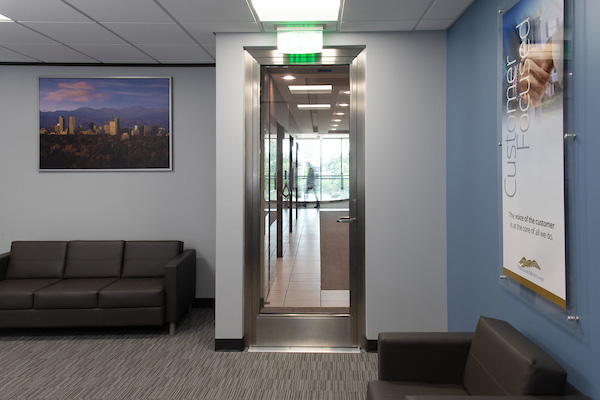
Photo: ® Carter & Fitzgerald
When traditional wired glass was the only glazing material offering fire protection, building codes limited fire-rated glass to 100 square inch vision lites in doors with stringent fire-rated criteria. As new fire-rated glass products entered the market with improved performance and impact safety protection, this restriction was removed.
Now, according to the International Building Code (IBC), glazing is permitted in fire-rated doors assuming it has passed the relative testing requirements (2021 IBC section 716.2.5.1). Glass size limitations are up to each door manufacturer (as tested/listed by independent testing agency). In addition, each door manufacturer will have their own stile and rail requirements.
Where the architect or building owner desires a full-lite, fire-rated glass door to maximize natural light or improve wayfinding, fire-protective glass doors with a 20- or 45-minute rating can often be used in the maximum size (as tested/listed by an independent testing agency). In doors with temperature-rise criteria, fire-resistive glass is an alternative. Since it is tested to ASTM E119, the standard for fire walls, it is suitable for use in all doors, without any size limitations beyond what has been tested and certified/listed by the manufacturer.
To meet a variety of design goals and fire- and life-safety needs, TGP offers fire-rated glass products approved for full-lite doors for 20-, 45-, 60- and 90-minute applications. See the Fireframes Designer Series and Fireframes Heat Barrier Series product pages, which list the maximum exposed glass sizes for each door system.
TGP also offers fire-rated glass approved for full-lite fire-rated wood or hollow metal doors by others for 20-, 45-, 60- and 90-minute applications. For ratings up to 180 minutes, the glass size is limited to 100 square inches.

A fire-rated doors’ frame material makeup directly impacts its ability to be painted. Common materials include hollow-metal steel (HMS), wood and extruded steel profiles.
HMS and extruded steel fire-rated doors and frames can be custom painted. Extruded steel frames can also be powder coated at the factory to meet project goals. The ever-expanding range of color schemes allow design teams to create a cohesive look throughout interior or exterior spaces without altering the frame’s fire- and life-safety performance.
Extruded steel profiles can also be finished coated at the factory to visually match nearby aluminum framing systems. In addition, stainless steel door frames are available.

When specifying hardware and framing products for fire-rated doors, the crucial first step is understanding the application, code and installation requirements.
Fire-rated door hardware and frames must be tested with the full door assembly to ensure the same fire ratings are met. Fire-protective offerings, such as Fireframes® Designer Series, can be used with wired glass, Fireglass® 20, Pilkington Pyrostop®, or the FireLite® family of products to meet project criteria. Fireframes® Heat Barrier Series doors can incorporate large panes of Pilkington Pyrostop fire-resistive-rated glass to uphold its fire-resistive properties.
Please consult your local TGP territory manager for project-specific information regarding fire-rated door hardware and frames.

Standard decorative glass treatments, such as custom etching and sandblasting, can create eye-catching doorways. However, applying these treatments in the field to fire-rated glass may compromise its fire- and life-safety performance.
To resolve this dilemma, manufacturers and suppliers now offer fire-rated glass with decorative treatments that meet fire- and life-safety criteria. For example, TGP offers fire-rated glass that can be lightly sandblasted or etched while still maintaining its fire rating. It can also be combined with colored, tinted or other decorative glass as part of an insulated glass unit (IGU). In either instance, the flexibility to vary the surface of the fire-rated glass provides a crucial design benefit for doors that serve as a character-defining feature of a building.

Fire-rated glass doors were once easy to identify with their thick fire-rated frames and the familiar crisscross pattern of wired glass, forcing a compromise on appearance to meet code requirements. While traditional hollow-metal steel fire door and frame assemblies can provide the necessary fire protection, the frame profile size, color or material may not match neighboring windows and curtain walls. Today, it is growing increasingly difficult to discern whether a door provides fire protection. In large part, this is due to advancements in fire-rated glass, door and framing materials.
TGP provides frames formed in an extrusion-like process that results in thin profiles, well-defined edges (rather than rounded profiles), and vertical-to-horizontal framing joints without visible weld beads or fasteners. As an added benefit, because the frames are made of carbon steel, an inherently heat-resistant framing material, they do not require thermal barriers within their core to achieve the necessary fire defense. This makes it possible for design teams to closely match the aesthetic and technical aspects of traditional aluminum frames in door applications requiring stringent fire protection. Such thin profile, fire-rated doors are ideal for assemblies integrated into fire-rated curtain wall, stairwell or entryways with stringent fire- and life-safety criteria.